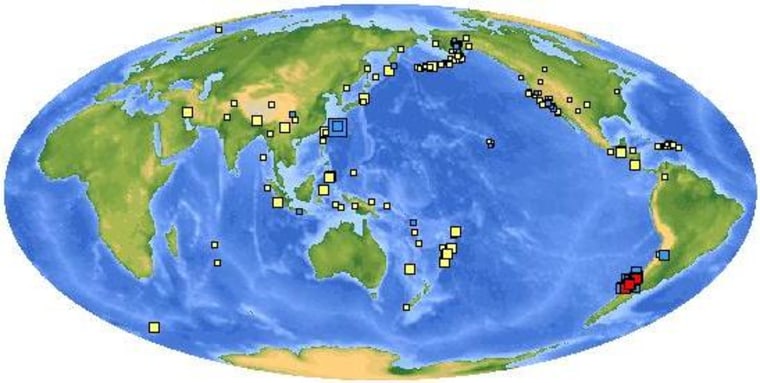Chile is on a hotspot of sorts for earthquake activity. And so the 8.8-magnitude temblor that shook the region overnight was not a surprise, historically speaking. Nor was it outside the realm of normal, scientists say, even though it comes on the heels of other major earthquakes.
One scientist, however, says that relative to the time period from the mid-1970s to the mid-1990s, Earth has been more active over the past 15 years or so.
The Chilean earthquake, and the it spawned, originated on a hot spot known as a subduction zone, where one plate of Earth's crust dives under another. It's part of the active "Ring of Fire," a zone of major crustal plate clashes that surround the Pacific Ocean.
"This particular subduction zone has produced very damaging earthquakes throughout its history," said Randy Baldwin, a geophysicist with the U.S. Geological Survey.
The largest quake ever recorded, magnitude 9.5, occurred along the same fault zone in May 1960.
Even so, magnitude-8 occur globally, on average, just once a year. Since magnitudes are given on a logarithmic scale, an 8.8-magnitude is much more intense than a magnitude 8, and so this event would be even rarer, said J. Ramón Arrowsmith, a geologist at Arizona State University.
Is Earth shaking more?
The Ryukyu Islands of Japan were hit with a 7.0-magnitude quake on Friday night. News of that tremor, the and now Chile may make it seem as if Earth is becoming ever more active. But in the grand scheme of things, geologists say this is just Mother Nature as usual.
"From our human perspective with our relatively short and incomplete memories and better and better communications around the world, we hear about more earthquakes and it seems like they are more frequent," Arrowsmith said. "But this is probably not any indication of a global change in earthquake rate of significance."
Coupled with better communication, as the human population skyrockets and we move into more hazardous regions, we're going to hear more about the events that do occur, Arrowsmith added.
However, "relative to the 20-year period from the mid-1970s to the mid 1990s, the Earth has been more active over the past 15 or so years," said Stephen S. Gao, a geophysicist at Missouri University of Science and Technology. "We still do not know the reason for this yet. Could simply be the natural temporal variation of the stress field in the earth's lithosphere." (The lithosphere is the outer solid part of the Earth.)
While the Chilean earthquake wasn't directly related to Japan's 7.0-magnitude temblor, the two have some factors in common.
For one, any that made their way from Japan to the Chilean coast could play a slight role in ground-shaking.
"It is too far away for any direct triggering, and those distances also make the seismic waves as they would pass by from the Haiti or Japan events pretty small because of attenuation," Arrowsmith told LiveScience. (Attenuation is the decrease in energy with distance.) "Nevertheless, if the Chilean fault surface were close to failure, those small waves could push it even closer."
In addition, both regions reside within the Ring of Fire, which is a zone surrounding the Pacific Ocean where the Pacific tectonic plate and other plates dive beneath other slabs of Earth. About 90 percent of the world's earthquakes occur along this arc. (The next most seismic region, where just 5 to 6 percent of temblors occur, is the Alpide belt, which extends from the Mediterranean region eastward.)
Colliding plates
The Chilean earthquake occurred at the boundary between the Nazca and South American tectonic plates. These rocky slabs are converging at a rate of 3 inches (80 mm) per year, according to the USGS. This huge jolt happened as the Nazca plate moved down and landward below the South American plate. This is called a subduction zone when one plate subducts beneath another.
(Over time, the overriding South American Plate gets lifted up, creating the towering Andes Mountains.)
The plate movement explains why coastal Chile has such a history of powerful . Since 1973, 13 temblors of magnitude 7.0 or greater have occurred there, according to the USGS.
In fact, the Chile earthquake originated about 140 miles (230 kilometers) north of the source region of the magnitude 9.5 earthquake of May 1960, considered the largest instrumentally recorded earthquake in the world. The 1960 earthquake killed 1,655 people in southern Chile, unleashing a that crossed the Pacific and killed 61 people in Hawaii, Japan and the Philippines.
In November 1922, a magnitude-8.5 earthquake occurred about 540 miles (870 kilometers) to the north of Saturday's earthquake, triggering a local tsunami that inundated the Chile coast and crossed the Pacific to Hawaii.
Because Saturday's earthquake was so huge, the amount of shaking experienced in Chile would likely have caused just as much damage had a similar-sized event occurred elsewhere, said Baldwin, the USGS scientist.
"If [the quake] were in Los Angeles you'd probably have massive destruction too," Baldwin said in a telephone interview.
